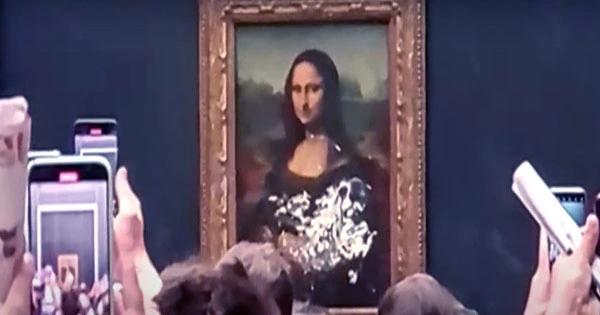One of the most well-known paintings in the world is the Mona Lisa. Leonardo da Vinci created this little portrait, which measures 76 by 53 centimeters (30 inches by 21 inches). It is presently housed at the Louvre in Paris, under tight protection, and is considered an Italian Renaissance masterpiece. And it’s a good thing, too, because a protester tried to vandalize the painting with a cream cake on May 29, 2022. A 36-year-old male dressed as an elderly lady in a wheelchair was the perpetrator. Bystanders said he leapt out of his wheelchair, attempted to destroy the bulletproof case, and when that failed, smeared cake on the glass and reportedly tossed flowers on the ground.
Security personnel apprehended him and led him out of the building with the empty wheelchair. He told bystanders in French, “There are people who are destroying the Earth” and “Artists should think about the Earth!” The stunt appeared to be motivated by climate activism, and he told bystanders in French, “There are people who are destroying the Earth” and “Artists should think about the Earth!” Every artist considers the environment. That’s why I went ahead and did it.”
The protester is supposed to have gotten so near to the art work because of the wheelchair disguise. The museum’s spokesman informed BuzzFeed News that the “normal protocols” for those with impairments had been followed. Fortunately, there was no damage to the artwork, but the Mona Lisa has had a tumultuous history, and this isn’t the first time it’s been targeted for vandalism or destruction.
Vincenzo Peruggia made international headlines when he stole the painting in 1911 by hiding it in a cupboard overnight, placing it under his smock, and walked out of the premises (after getting help from an unsuspecting plumber trying to do a good deed). For the first 24 hours, no one knew the painting had been taken, but when it was discovered, it was plastered across the front pages of worldwide newspapers. Peruggia was apprehended two years later, and the Mona Lisa was recovered.
1956 was a difficult year for the Mona Lisa as well. The lower section of the picture was soaked in acid early in the year. Ugo Ungaza Villegas then hurled a rock at the artwork in December, injuring her left elbow. The picture has been protected by bulletproof glass since these events. The photograph was placed in a complicated case in 2005. This bulletproof and non-reflective case contains an air treatment system that regulates the temperature and relative humidity within the case.
This is crucial because the painting is oil on poplar support, and keeping the humidity at an optimal level is critical for conservation since variations can cause the support to shrink – the support has shown evidence of warping in the 500 years since it was created. A unique LED bulb is also used to illuminate the painting, which enhances the colors while reducing UV radiation. When a Russian lady who refused French citizenship hurled an empty teacup at the image, the bulletproof glass rescued it once again. This attack, on the other hand, only scratched the surface of the case.















